November 2012 has been a good month for seeing Eurasian Bullfinch Pyrrhula pyrrhula in the ROK – with records throughout the country. This note is written to share some images of the various taxa and to seek help in improving identification criteria – as e-mails to that effect sent this month to various list-servers and to folks who have handled these birds have so far drawn a complete blank…Can you help?
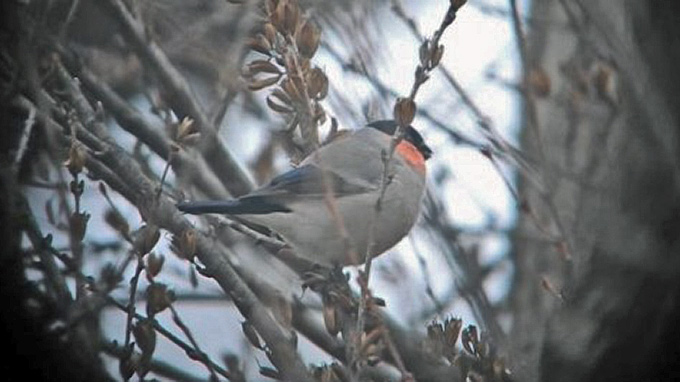
© Nial Moores / Birds Korea.
Introduction
Across its vast range (from Western Europe to Kamchatka), both male and female Eurasian Bullfinch are stubby-billed and distinctively black-capped and white-rumped. In Western Europe, differences between the various subspecies are fairly subtle (see e.g. Pennington and Meek 2006). First-winters are believed to resemble adults (with major differences confined to the greater coverts and alula: Svensson 1992). Adult males of all taxa have much red on the underparts, and are obviously brighter below than adult females (which are generally brown or brownish).
In contrast, in East Asia male underpart colour can be all-grey (cineracea); red-cheeked and cool ash-grey breasted and bellied (griseiventris); red-cheeked and reddish-brown breasted and bellied (rosacea); pink (cassini); or red (nominate pyrrhula). Most males have greyish upperparts (with a greyish bar across the greater coverts), though rosacea can appear brown-toned above and pyrrhula should (perhaps!) be cleanest grey above and show some pure white in the wing-bar. Females are much duller than males, often brown-toned below and above – though sexual dimorphism is much reduced in cineracea. Females are therefore generally described or depicted as grey (cineracea), greyish-brown (griseiventris), dark brown (rosacea) or brown (the two other taxa) on the underparts, and greyish or grey-brown on the upperparts.
In both sexes, there is believed to be some variation in the extent of white or whitish in the undertail, with cassini perhaps showing the most white and griseiventris and cineracea the least.
It is generally assumed that First-winters differ from adults as in Western Europe. However, some online resources appear to assume that at least First-winter male griseiventris can be almost all grey on the underparts, without red cheeks (see for example the “probable First-winter male griseiventris” on November 3rd 2012 at:
http://amurbirding.blogspot.kr/2012_11_01_archive.html).
Figure 2 is a coarse approximation of breeding areas of these various East Asian taxa. All are believed to be partially migratory, and all but nominate pyrrhula (surprisingly, considering how close it is supposed to occur) have been claimed on the Korean Peninsula.
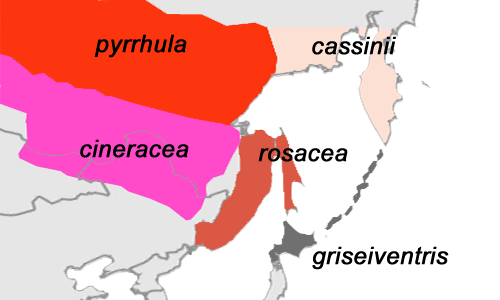
Eurasian Bullfinch in the ROK
In the ROK, Eurasian Bullfinch is a winter visitor, with most records from mid-October to March. There are perhaps no records of juveniles.
Rosacea, as might be expected from its range, is the most numerous Eurasian Bullfinch taxon in the ROK. It is a generally uncommon winter visitor, scarcer southward, usually found in mixed forest and wooded parkland in hilly or mountainous areas.
In males, the cheeks are red and the underparts reddish, variably washed through with brown or greyish-brown. The upperparts can also appear rather brown-washed. Males generally considered to be rosacea are therefore those birds that lie between cassinii / pyrrhula and griseiventris in breast and upper belly coloration.

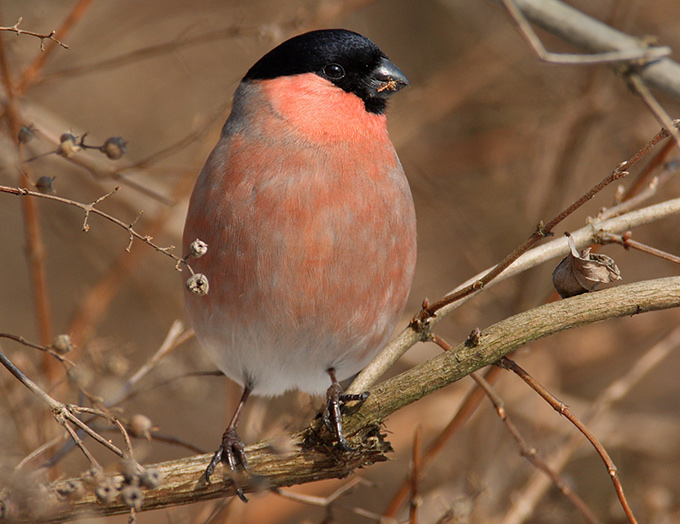
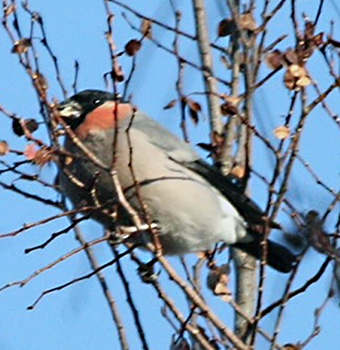
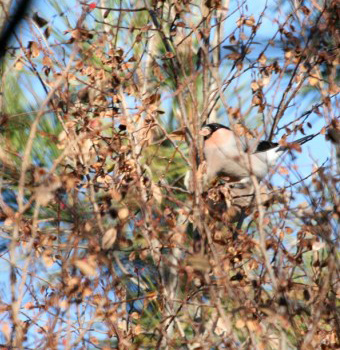
Presumed female rosacea are rather dark brown on the upper and underparts (as in Fig. 3), with some perhaps occasionally showing a hint of pinkish-brown tones on the cheeks and breast (see Figure 14 in Pennington and Meek 2006 for a female pyrrhula also showing pink below the cap).

By late November 2012, rosacea had already reached as far south as Geoje and Busan. An adult male was even photographed on the Japanese Island of Miyakejima (at approximately 34.08N, 139.53 E) by Peeter Musta on November 17th.
Both Austin (1948) and Tomek (1999-2002) (who cited Won Hong-Koo 1963-1965) considered cassini (not pyrrhula) to have been recorded in the DPRK. Brazil (1991) also regarded cassini as a rare winter visitor to Japan (with only four or five specimen records there by that time).
Austin (1948) described the “northeastern race” cassini as “larger and markedly redder” than rosacea. Cassini is therefore the name generally given to males in Korea with red underparts that are concolorous with the cheeks – varying in tone from pinkish to deeper red (latter type perhaps instead referrable to nominate pyrrhula?). This taxon is a very uncommon or even rare winter visitor to the ROK.
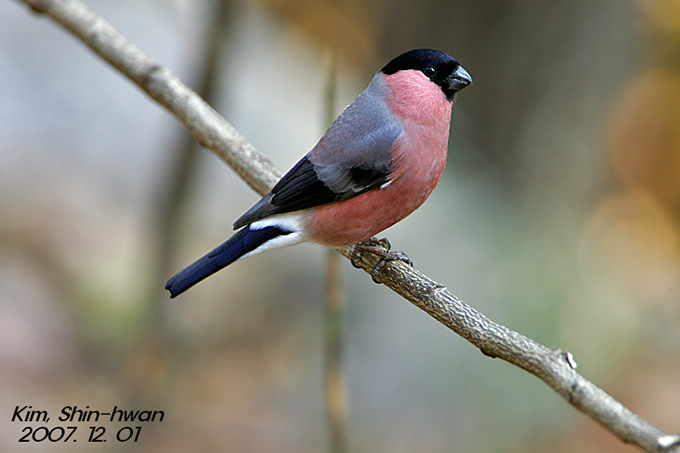
It is still unclear at present whether birds with a faint brown wash across the pink of the underparts should be considered as “cassini-types” with some rosacea influence or simply as dull (First-winter?) male cassini. Note that the mapped breeding range of cassini “meets” the nominate subspecies in a wide area, but should be more or less isolated by open sea from griseiventris and rosacea.

At some angles it appeared clean salmony- pink below, while at other angles (as here) it showed some contrast between the
clean pink of the cheeks and the slightly duller breast and belly.
Although considered by some authors to be synonymous with rosacea, true griseiventris is restricted as a breeder to Honshu, Hokkaido and the Kurile Islands. Males are especially striking to look at – with bright pink cheeks cut off distinctly from cool grey underparts.
A male present in the national arboretum (in Gwangneung, east of Seoul) between at least December 22nd 2005 (when first found by NM) and February 13th 2006 (when photographed by Jim Parkas), was perhaps the first adequately-documented ROK record of this taxon.
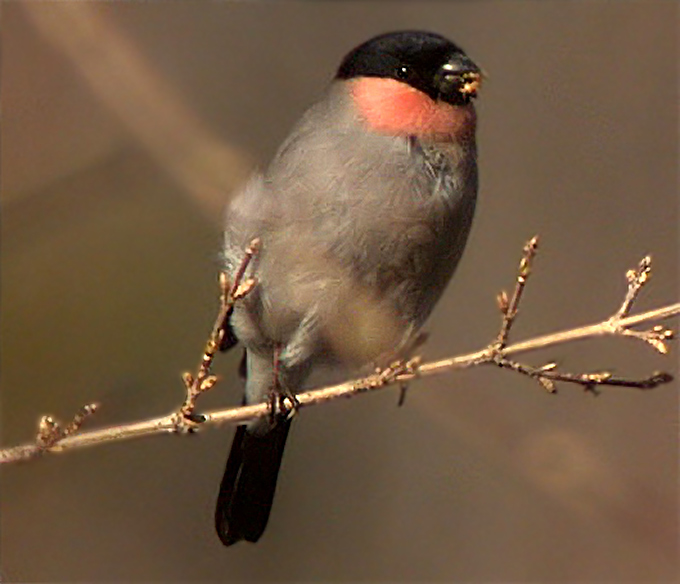
Note that some of the underpart warmth in the image is from the branches in front of the bird.
A second, even cooler-grey toned male was found at the same location (by NM, Brad Sulentic and Jimm Edgar) on November 23rd 2012, when some poor digiscope images and short video were taken.
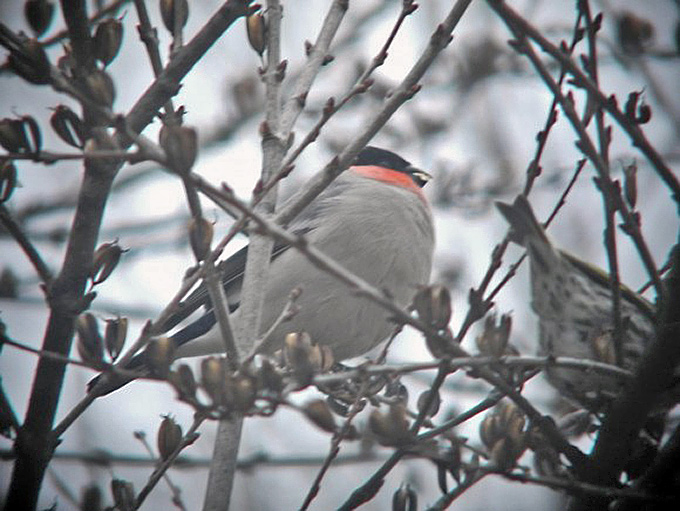
Cineracea is a north-western taxon that, based on its mapped range, might seem most unlikely to occur in the ROK. However, Tomek (2002) cites Won Hong Koo as stating that cineracea had been recorded during the breeding season in northernmost Korea. In addition, Austin (1948) saw a “singularly blue-grey” female, which he considered “probably” to be a cineracea, in a small series of birds collected in November 1929 in the far north-eastern provinces of present-day DPRK. It seems possible, therefore, that the range of cineracea might extend rather further east than is usually recognised (again, note the banding records of at least one cineracea and two putative griseiventris – also perhaps cineracea?- in autumn 2012 at Muravioka Park in eastern Russia on the Amur Birding Blog).
Identification criteria of this taxon remain especially poorly-known, despite it being considered by some Russian authorities to be a full species. A range of online sources suggest that it can show a trace of pinkish tones, especially immediately below the cap, and that although it has greatly reduced sexual dimorphism some females can appear faintly brown-washed across the flanks.
One bird in the mixed flock of Eurasian Bullfinch at the National Arboretum on November 23rd 2012 appeared strikingly grey both above and below in brief binocular views. It was then disgiscoped briefly and by chance as it fed alongside the male griseiventris, unfortunately from below at dusk. In direct comparison with the male griseiventris, it appeared similarly-sized, though perhaps with an even stubbier bill, with similarly-toned grey underparts. However, it also showed a faintly brown wash to the flanks and some faint warmth immediately below the cap. In combination, it appeared out of the range of rosacea and cassini, and unlike any plumage of griseiventris known to NM.

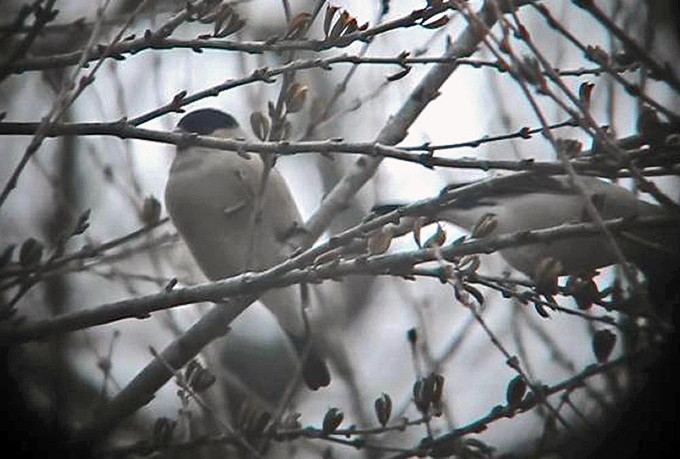
In summary, many questions remain about the identification of these taxa. As always, informed comment and permission to post images of individuals of known identity from other areas will be most welcomed!
- Austin, O. L., Jr 1948. The birds of Korea. Bulletin of the Museum of Comparative Zoology, Harvard University 101: 1-301.
- Brazil, M. 1991. The Birds of Japan. Published by Helm.
- Brazil, M. 2009. Birds of East Asia. Helm Field Guides.
- Pennington, M. & E. Meek. 2006. The ‘Northern Bullfinch’ invasion of 2004. British Birds 99. January 2006 > 2-24 (pre-publication pdf).
- Svensson, L. 1992. Identification Guide to European Passerines. Published and sold by the author.
- Tomek, T. 1999-2002. The birds of North Korea. Acta Zoologica Cracoviensia 42: 1-217; 45: 1-235 (in English).
- Won H-K. 1963-65. [The birds of Korea]. Pyongyang, 1-3 (in Korean).



